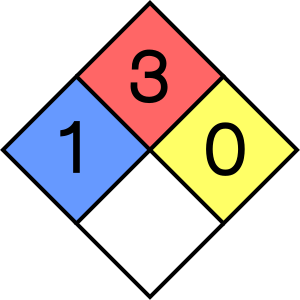ACETONE
Basic information
- Chemical formula(s): \({\rm C_3H_6O}\), \({\rm (CH_3)_2CO}\)
- Other names: 2-propanone, propan-2-one, dimethyl ketone, methyl ketone
- CAS: 67-64-1
- International Chemical Safety Card (ICSC): 0087
- Flammability: yes - highly flammable
- NOAA’s description: clear colourless liquid with a sweetish odour, liquid lighter than water, vapours heavier than air
NFPA 704 (fire diamond)

- Health (blue): 1 - exposure would cause irritation with only minor residual injury.
- Flammability (red): 3 - it can be ignited under almost all ambient temperature conditions. Its flash point is -20 °C. It’s autoignition temperature is 465 °C.
- Instability–reactivity (yellow): 0 - normally stable, even under fire exposure conditions, and is not reactive with water.
- Special notice (white): -
Hazard statements
| Code | Phrase |
|---|---|
| H225 | highly flammable liquid and vapour |
| H302 | harmful if swallowed |
| H319 | causes serious eye irritation |
| H336 | may cause drowsiness or dizziness |
| H373 | may cause damage to organs through prolonged or repeated exposure |
Precautionary statements
| Code | Phrase |
|---|---|
| P210 | keep away from heat, hot surfaces, sparks, open flames and other ignition sources, no smoking |
| P235 | keep cool |
| P260 | do not breathe dust/fume/gas/mist/vapours/spray |
| P305+P351+P338 | IF IN EYES: rinse continuously with water for several minutes, remove contact lenses if present and easy to do, continue rinsing |
Protective measures
Gloves
Occupational Safety and Health Act of 1970 and OSHA Glove Selection Chart categorize gloves into four protection levels (very good, good, fair, poor (not recommended)) for given chemical. The levels of protection against acetone for four types of gloves are:
- Neoprene: good for limited service.
- Natural latex or rubber: very good for limited service.
- Buthyl: very good for limited service.
- Nitrile: poor.
Safety goggles
- Always wear safety goggles when handling acetone. Corrective glasses are not considered safety googles.
- Handle acetone inside the fume hood only (with exception of moving the closed bottle to and from the storage cabinet).
Clothing
- Wear long trousers and fully covered shoes.
- Contact lenses are forbidden while working with chemical substances, even in combination with safety glasses.
- Do not wear cosmetics.
- Do not wear synthetic clothing while working with flammable liquids or gases or when a hazard is present as these materials tend to melt and stick to exposed skin.
- Do not wear headphones.
Spill management
- Use personal protective equipment.
- Avoid dust formation, avoid breathing dust.
- Avoid breathing vapors or mist.
- Ensure adequate ventilation.
- Evacuate personnel to safe areas.
- Sweep up without creating dust and arrange disposal.
- Do not let it enter drain.
- If a spill happened outside the fume hood (on the floor or desktop) contact Dr Jakub Tkaczuk (+41 44 632 31 62) and the ETH Emergency Desk (+41 44 342 11 88 from mobile or 888 from landline).